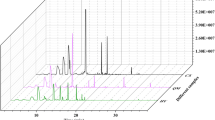Abstract
The volatile flavor compounds of roasted Italian chestnuts, which have not been studied prior to this report, were determined by capillary gas-chromatography with a mass selective detector. Samples were obtained by SPME directly from the headspace of freshly roasted and ground chestnuts as well as by previous extraction with dichloromethane. Monoterpenes and derivatives of butane, pentane, hexane, and heptane were identified as important aroma impact compounds. γ-Butyrolactone (12.8%), γ-terpinene (9.2%), furfural (6.3%), benzaldehyde (7.2%) and 4-methyl-2-pentanone (5.3%) were found in concentrations higher than 5.0% (calculated as % peak area of GC-MS analysis using a nonpolar column).
Similar content being viewed by others
References
McCarthy MA, Meredith FI (1980) Nutrient data on chestnuts consumed in the United States. Econ Bot 42:29–36
Senter SD, Payne JA, Miller G, Anagnostakis SL (1994) Comparison of total lipids, fatty acids, sugars and nonvolatile organic acids in nuts from Castanea species. J Sci Food Agric 65:223–227
Morini G, Maga JA (1995) Changes in the fatty acid composition of roasted and boiled Chinese (Castanea molissima) and Italian (C. sativa) chestnuts grown in the same location. Generation, analysis and process influence. In: Charalambous G (ed), Food flavors. Elsevier, Amsterdam, pp 563–568
Künsch U, Schärer H, Patrian B, Hurter J, Conedera M, Sassella A, Jerimini M, Jerimini G (1999) Quality assessment of chestnut fruits. Acta Hort 494:119–127
Künsch U, Schärer H, Patrian B, Höhn E, Condera M, Sassella A, Jermini M, Jelmini, G (2001) Effects of roasting on chemical composition and quality of different chestnut (Castanea sativa Mill.) varieties. J Sci Food Agric 81:1106–1112
Ferreira-Cardoso J, Sequeira CA, Torres-Pereira JMG, Rodrigues L, Gomes EF (1998) Lipid composition of Castanea sativa Mill fruits of some native Portuguese cultivars. Second international symposium on chestnut, Bordeaux, 19–23 October 1998, pp 133–138
Conner W E (1997) The beneficial effects of omega-3 fatty acids: cardiovascular disease and neuro-development. Curr Opin Lipidol 8:1-3
Adua M (1998) The sweet chestnut throughout history from the miocene to the third millennium. Second international symposium on chestnut, Bordeaux, 19–23 October 1998, pp 29–36
Adua M (1998) Sweet chestnut production and marketing in Italy. Second international symposium on chestnut, Bordeaux, 19–23 October 1998, pp 49–54
Condera M (1996) Die Kastanie, der Brotbaum Bündnerwald 49: 28–46
Gloaguen V Nourani D, Morvan H (1998) Chestnut envelopes contain xylan- and polygalacturonic acid-rich polysaccharides. Second international symposium on chestnut, Bordeaux, 19–23 October 1998, pp 139–142
Arctander S (1969) Perfume and flavour chemicals. Arctander, Montclair, NJ
Bauer K, Garbe D, Surburg H (1997) Common fragrance and flavor material. VCH, Weinheim, Germany
Furia TE, Bellanca N (1975) Feneroli’s handbook of flavour ingredients. CRC, Cleveland, OH
Sigma-Aldrich (2001) Flavors and fragrances, the essence of excellence. Sigma-Aldrich, Milwaukee, WI
Maga JA (1991) Nuts. In: Maarse H (ed) Volatile compounds in foods and beverages. Dekker, New York, pp 671–688
Morini G, Maga JA (1995) Volatile compounds in roasted and boiled Chinese chestnuts (Castanea molissima). Lebensm-Wiss u-Technol 28:638–640
Bonaga G, Giumanini AG (1986) The volatile fraction of chestnut honey. J Apicult Res 25 2:113–120
Bonvehi JS, Coll FV (2003) Flavour index and aroma profiles of fresh and processed honeys. J Sci Food Agri 83:275–282
Author information
Authors and Affiliations
Corresponding author
Rights and permissions
About this article
Cite this article
Krist, S., Unterweger, H., Bandion, F. et al. Volatile compound analysis of SPME headspace and extract samples from roasted Italian chestnuts (Castanea sativa Mill.) using GC-MS. Eur Food Res Technol 219, 470–473 (2004). https://doi.org/10.1007/s00217-004-0983-5
Received:
Revised:
Published:
Issue Date:
DOI: https://doi.org/10.1007/s00217-004-0983-5




